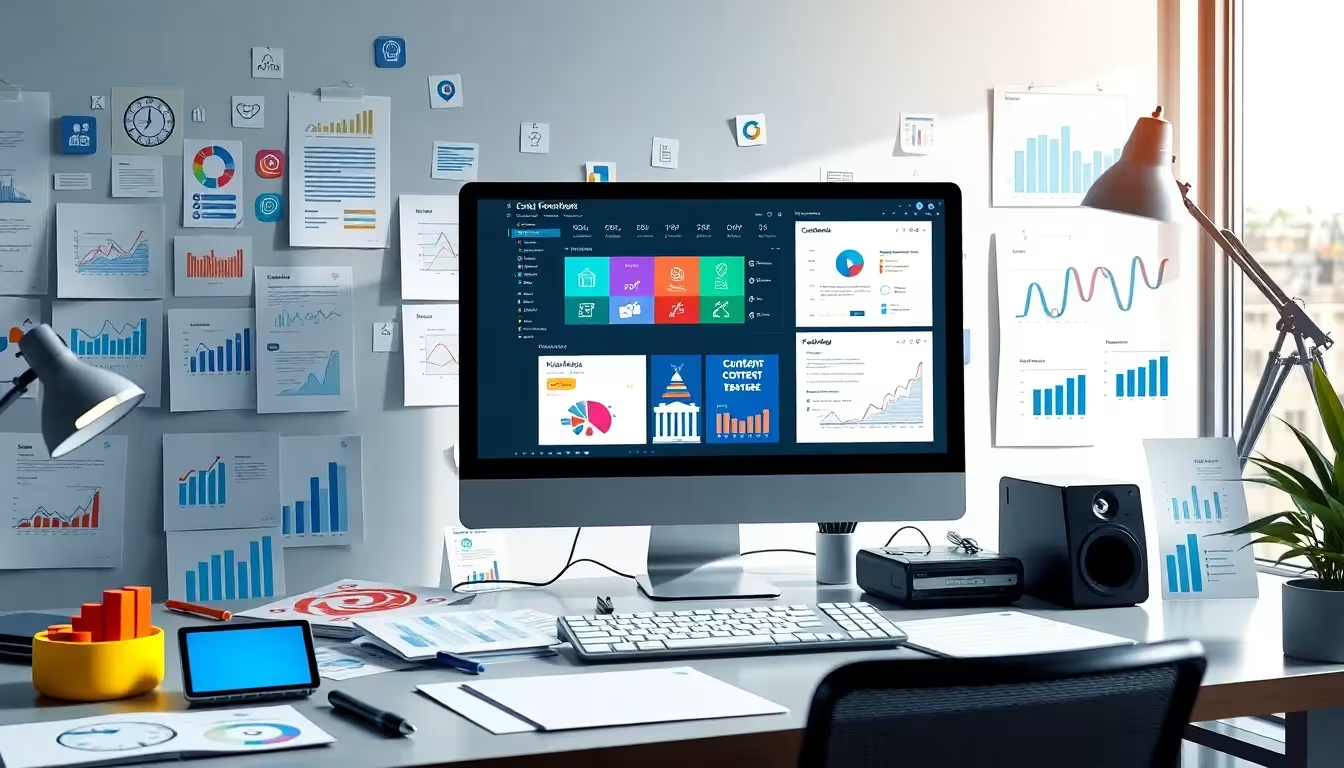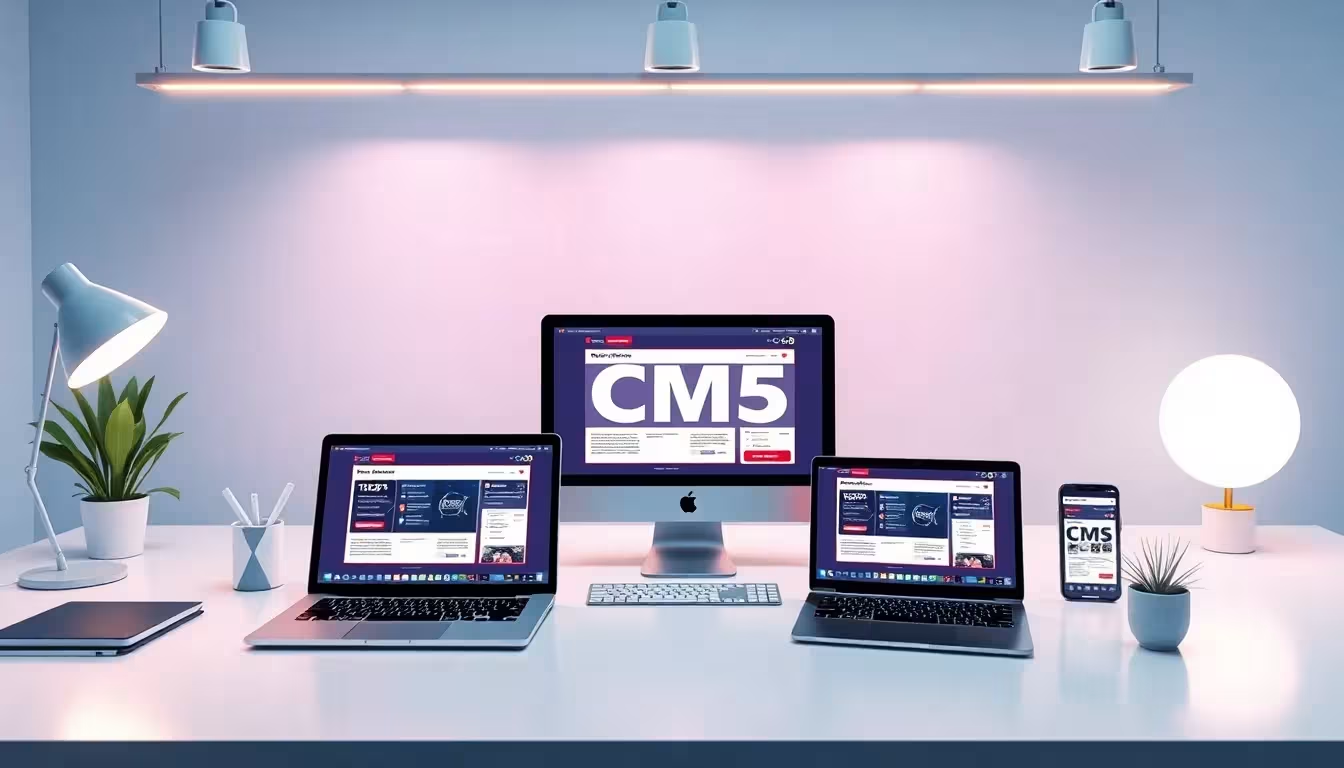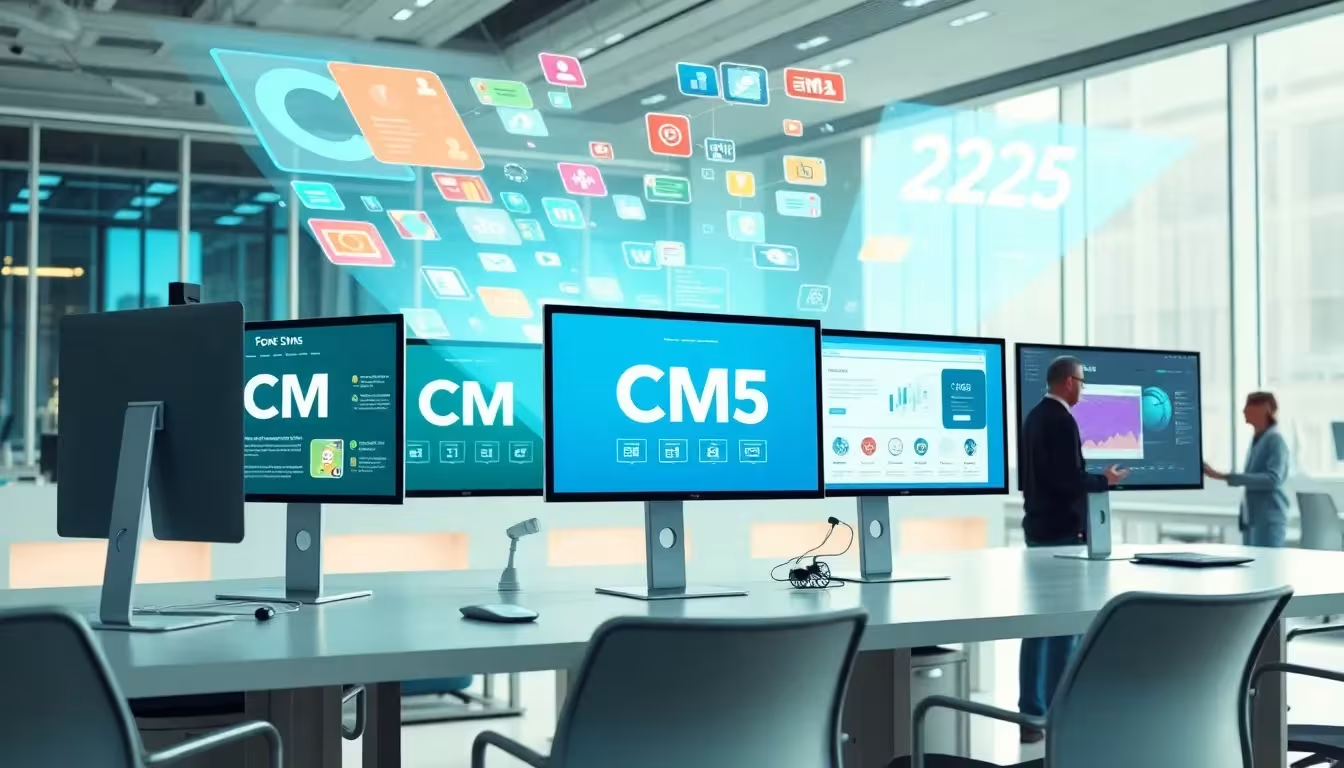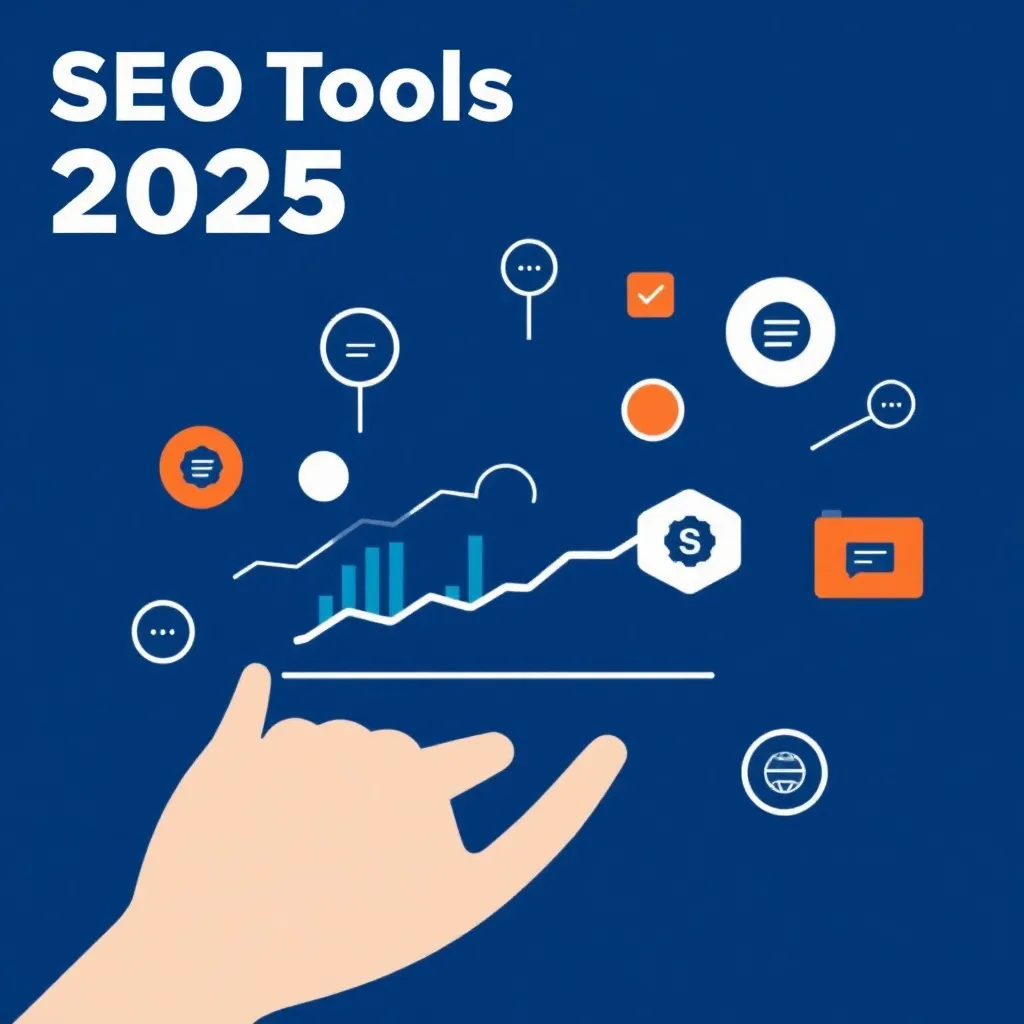CMS systems in 2025 offer a wide range of functions tailored to different requirements - from simple blogs to comprehensive e-commerce solutions. In this article, I will show you the best platforms for your online presence in 2025 and what you should look out for when making your choice.
Key points
- WordPress remains a leader and versatile
- Headless CMS offer maximum flexibility for developers
- Shopify is ideal for quick e-commerce entry
- CRM integration is gaining relevance with systems like HubSpot
- Composable CMS like Storyblok offer high modularity

Especially in times when online presences are becoming increasingly individualized, it is worth taking a look at the detailed functions of the various CMS systems. You should not only pay attention to the distribution or the pure cost structure, but also keep an eye on the modular expandability and future trends. Many CMS platforms combine classic content management with marketing and analysis functions. At the same time, performance is more important than ever, as visitors demand fast loading times and smooth navigation.
Below you will find a comprehensive overview of the most important CMSs in 2025. You will also find out how you can make the best use of certain platforms to find the right CMS strategy for your project in the long term.
WordPress - all-rounder with community power
WordPress continues to dominate the market with over 65 % share and incredible extensibility with over 58,000 plugins. I use WordPress for blogs as well as for business sites, as the platform offers both inexpensive as well as technically versatile. Thanks to REST and GraphQL APIs, modern headless architectures can also be easily implemented.
The large developer community ensures continuous innovation. Through the comparison with Joomla and Typo3 shows that the intuitive operation of WordPress is a decisive advantage. Even for e-commerce via WooCommerce, the foundation is well laid - but not as specialized as Shopify.
For me, WordPress remains the easiest way to enter the CMS world without compromising on professional requirements. It is also interesting to see how WordPress has increasingly relied on block editors since version 6.x. The Gutenberg editor offers ever more extensive options for combining layout and content in the frontend and backend workflow. At the same time, more and more beginners and professionals are paying attention to clean rights management in order to increase security. As WordPress is very widespread, you can quickly find answers to problems in topic-specific forums or in the official documentation.
An important future prospect for WordPress is the integration of automated translation functions via AI platforms, which can be implemented using plugins. This offers flexible multilingualism without having to rely on external tools. The growing demand for AI-supported analysis tools and chatbots is also addressed by the diverse range of plugins, allowing you to provide your visitors with personalized content and services.
Typo3 - For structured company portals
Typo3 is suitable for medium-sized and large organizations thanks to its fine-grained rights management and the integrated multilingualism. Projects that require a lot of editorial access or are rolled out in several countries clearly benefit from the backend design of this CMS.
As it is open source software, there are no fixed license costs - ideal for long-term web projects. The good documentation enables developers and administrators to get started efficiently. Anyone who needs complex editorial workflows or individual backend structures, for example, will find the necessary support here.
One advantage is that Typo3 has continued to work on user-friendliness in recent years. Where you used to find a bulky-looking menu, you will now find clearer structures and customizable admin interfaces. Especially for industries that rely heavily on compliance and audits, Typo3 offers many options for precisely defining access rights and carrying out version controls for individual page elements. This means that even larger teams can be coordinated efficiently, for example if individual departments are only allowed to edit certain content.
For 2025, it is clear that Typo3 will remain relevant as a robust system for complex projects. It forms a stable foundation that can be adapted in many ways through extensions and integrations (e.g. with third-party systems or CRM solutions). Even large websites with high traffic volumes do not lose speed and remain secure when modern caching concepts and CDN connections are used.

Shopify - Get started quickly with online sales
Shopify helps beginners and smaller teams to offer an online store that works on all levels within hours. Convincing for me: the system offers a well thought-out user interface and Automated e-commerce functionsincluding warehouse management and analysis tools.
With AI-supported product recommendations, Shopify also stands out in the e-commerce sector in 2025. You should plan for fees for payment processing and transactions, but the costs for setup and operation remain low. Anyone who wants to take a pragmatic approach to e-commerce will work efficiently with Shopify.
Compared to larger on-premise solutions, Shopify is virtually maintenance-free, as hosting and security are handled directly by the provider. This means you can focus more on marketing and product descriptions instead of tweaking server settings or updates. Shopify also offers a sophisticated network of themes and ready-made templates so that the design can be customized quickly.
One plus point is the new focus on social commerce: Shopify can be easily connected to social media channels so that you can advertise and sell products directly via Facebook, Instagram or TikTok. This allows you to reach more potential customers without having to constantly maintain product data manually. At the same time, many agencies are developing their own Shopify apps to cover specific requirements. In short: if you need a professional online sales platform quickly in 2025, Shopify is the right choice.
Strapi - Modern API-first architecture
Strapi gives me maximum flexibility when I want to publish content across channels: whether web, mobile apps or IoT - strict data management via JSON APIs is available. As a developer, I use the Headless approach from Strapi to make the frontend and backend independent.
The platform remains open source and offers many security functions as well as native support for internationalization. It is an ideal CMS for agencies and developers, especially when agile front-end development and structured back-ends are required. Strapi relies on modern frameworks and can be easily combined with existing tool chains.
Strapi scores particularly well in hectic projects with short release cycles thanks to its modular architecture. The user interface can be customized so that editors only see what they really need for their work. At the same time, developers can create new fields and data structures without having to reconfigure the entire CMS. This flexible approach makes Strapi a favorite for start-ups that want to scale quickly or companies that want to create innovative platforms with added value.
2025 is also the year in which many companies will increasingly rely on mobile and conversation-based interfaces. With a headless CMS like Strapi, you can use the same content repository for any type of frontend, from classic web stores to smart chatbots. This not only simplifies maintenance, but also branding, as everything is fed from a standardized data structure.

Storyblok - Modular, clearly structured, future-proof
Storyblok is based on a so-called composable approach: I only activate the functions that my project actually needs. This is particularly useful if unnecessary features are to be avoided and the Performance to be optimized. As a developer, I can focus fully on front-end rendering, while those responsible for editorial work in parallel in the visual editor.
The API structure is compatible with modern JavaScript frameworks such as Vue.js or React. Storyblok is a clear recommendation for projects with frequently changing requirements or MVP setups (minimum viable products). Start-ups and agencies are also increasingly relying on it.
What is interesting here is the continuous development of the visual editor, which is constantly refining the live preview principle. This allows content managers to see directly how changes affect the layout without having to wait for browser refreshes. This is a real time-saver, especially for teams that want to continuously test new ideas and landing pages.
Another aspect is the focus on microservices. Thanks to the composable architecture, every service - from asset management and personalization functions to marketing automation - is integrated on a modular basis. This keeps the CMS lean and makes it much easier to respond to individual requirements instead of having to manage a monolithic system. This makes projects in 2025 much more flexible and future-proof.
HubSpot Content Hub - CRM meets CMS
HubSpot Content Hub enables me to combine content and customer relationships directly. The platform is specifically aimed at companies that want to avoid data silos. With dynamic content personalization and enterprise-level security, the CMS is particularly suitable for growth-oriented marketing teams.
CRM integration allows content to be individualized based on user behaviour. Ideal for lead generation, newsletter marketing and campaign management. However, I see clear limitations in e-commerce: The system is less optimized for product catalogs and checkout processes.
However, if you want to integrate a comprehensive marketing suite into the CMS, HubSpot Content Hub provides a solid basis. You can track leads, set up email automation and link blog posts to landing pages. Everything happens in one platform, which makes data management much clearer. This interaction is a competitive advantage, especially for B2B companies that rely heavily on lead nurturing, because customer data, inquiries and marketing automation all come together in one place.
In terms of system integration, HubSpot can be easily connected with third-party providers. There are numerous extensions for payment providers, social media platforms and analysis tools. This is particularly valuable if you already want to work with an existing e-commerce system or ERP and want to synchronize customer data smoothly. Despite the clear focus on marketing, HubSpot Content Hub can deliver solid performance, provided you use the built-in optimizations such as automatic image compression and caching solutions.

CMS systems in comparison - functions and areas of application
In a direct comparison, the platforms show clear strengths and differences. The following table will help you to better classify the CMS systems in 2025:
| System | Strengths | Ideal for | License model |
|---|---|---|---|
| WordPress | Plugins, Community, Headless | Blogs, company websites | Open Source |
| Typo3 | Multilingualism, rights | Organizations, portals | Open Source |
| Shopify | Store functions, AI | E-commerce to SMEs | Licensed from 24 €/month |
| Strapi | API-first, security | Developer, SaaS products | Open Source |
| Storyblok | Composable design, visual CMS | Agencies, MVPs | Freemium |
| HubSpot Content Hub | Content + CRM | Marketing teams | Licensed |
When choosing the right license model, it is always worth taking a long-term view of the costs. While open source systems such as WordPress, Typo3 or Strapi do not incur any license fees, operation, updates and maintenance can still generate costs that should not be underestimated. Conversely, with Shopify or HubSpot you pay regular fees, but have a central point of contact for support and don't have to worry so much about technical details.
Advanced functions of modern CMS platforms
Many CMS systems 2025 rely on special functions that go far beyond traditional content. Some of them significantly increase efficiency:
- Authorization systems for fine-grained user management
- Headless options with API access
- Visual editors for content preview
- CRM connection for automated marketing
- International localization with string management
If you want to delve deeper into these functions, you can find more information at Detailed CMS functionalities at a glance a good introduction.
In addition, more and more systems are attaching importance to barrier-free design and accessibility. Modern design guidelines and accessibility features such as ARIA labels or dynamic font sizes are becoming increasingly relevant. Especially if you want to address a broad target group - or have compliance requirements regarding accessibility in certain countries - a CMS that supports these aspects out of the box or can be easily extended with plugins and add-ons is helpful.
Extensive personalization functions are just as important: Users should not be trapped in a one-size-fits-all environment, but instead receive context-dependent content and recommendations. Whether it's product suggestions in the online store, individual dashboard views or customizable user profiles - in 2025, personalized offers will become increasingly popular and significantly enhance the user experience.

Technical optimizations and security
Security and loading speed will play a greater role than ever in 2025. Many CMS systems now automatically integrate functions such as caching, two-factor authentication or automatic backups. For users of Joomla, for example, it is worth taking a look at the Joomla optimization via Plesk.
Headless systems such as Strapi or Storyblok are also increasingly relying on security principles such as minimal rights assignment or JWT tokens. Developers can specifically secure API endpoints and dynamically restrict access paths.
In view of increasing cyber attacks, it is now good practice to install security updates promptly and encrypt access data. Professional hosting providers offer security concepts and firewalls specially tailored to individual CMS types, so that many risks are already minimized at server level. Cloud hosting is now also widely used to dynamically absorb peak loads and store data in a geographically distributed manner.
If your project is growing rapidly, you should plan for scalability right from the start. Some CMS systems offer integrated load balancers and cluster solutions. Alternatively, you can use content delivery networks to keep static content such as images or videos close to the users. In this way, the website remains responsive, even with increased traffic.

Expanded perspectives: performance, SEO and AI
Today, content management systems have to meet completely new requirements in order to rank high in search engines and offer convincing performance. SEO basics such as meta tags, optimized URLs and a logical page structure have long been standard. However, in order to survive against growing competition, modern CMS platforms must enable more in-depth optimization.
One focus here is on Core Web Vitals, which Google has defined as an important ranking criterion. Fast loading times, responsive interaction and stable layouts make the difference between users leaving the site or staying. Modern CMS such as WordPress offer numerous plugins for this purpose, which can be used to automate caching and compression mechanisms. Headless solutions such as Strapi or Storyblok can circumvent performance bottlenecks by only providing targeted data that is required for a specific frontend request.
AI functions also play a key role in providing personalized content or automated translations. In a globalized environment, users expect websites to recognize their language and adapt content dynamically. It will be easier for marketers to set up personalized campaigns if the system automatically performs segmentation or generates product suggestions. As user behavior will become increasingly dynamic in 2025, a flexible and adaptable system architecture will be particularly valuable.
Accessibility and UX trends 2025
Another key aspect of modern CMS solutions is barrier-free design so that as many user groups as possible can access your content. This applies not only to people with disabilities, but also to those who surf on mobile devices or have a weak internet connection. Modern themes and templates take aspects such as high-contrast color schemes, clear navigation structures and adaptable font sizes into account.
At the same time, UX trends such as micro-interactions, chatbots and gamification play a role in many projects. This is where headless and composable systems show their strengths, as they can offer short, interactive experiences at different touchpoints. Integrations with chatbots or social media channels are usually easy to implement, provided the CMS has the right interfaces. For a future-proof project, you should also check how flexible the system is in terms of front-end integration and UX design when selecting a CMS.
Which platform suits your project?
Each platform meets different requirements. I recommend that you don't base your choice of CMS on the zeitgeist, but on your specific goal. Build an editorial system that suits your workflow - whether with headless architecture, CRM connection or a modular interface.
WordPress covers many cases, while Shopify offers the fastest way into online business. Companies with a clearly structured content strategy are better off using Typo3 or HubSpot. Developer solutions such as Strapi and Storyblok impress with their free API architecture and modern interfaces.
Especially if you are wavering between two or more platforms, a short proof of concept is often worthwhile. This can mean running a test installation and creating a small sample page. This will quickly show you whether the ease of use meets your expectations and whether all the necessary features can be integrated without any major detours. Demo accounts or freemium models for systems such as Shopify or Storyblok also make it easier to get started.
It also makes sense to think about the future growth of your project. A solution that is sufficient for a small blog could quickly reach its limits if you suddenly need e-commerce features or your traffic increases significantly. Conversely, a powerful enterprise CMS such as Typo3 may be oversized and too complex for a mini project.
Also think about your team: How big is your editorial team? Do your employees have technical know-how, or will they prefer an intuitive editor? Together with your long-term business goals, this should guide your decision.
Further considerations for your online presence
Before you make a decision, it is advisable to draw up a catalog of requirements and wishes. The following questions may be helpful:
- How often should new content be published?
- Would you like to integrate an online store or expand it in the future?
- Is multilingualism required?
- Should external systems be connected via APIs (e.g. ERP, CRM, analytics)?
- How important is sophisticated rights management in the backend for you?
- Are there any special legal requirements (data protection, accessibility, etc.)?
By clarifying these questions in advance, you can save time and avoid problems later on during the migration. Thorough planning is particularly worthwhile for corporate websites in order to avoid redundancies and unnecessary migrations. Feedback from your development team or an agency that already has experience with different CMSs often helps here.
Concluding thoughts
The world of CMS has developed rapidly in recent years and will continue to do so in 2025. With headless architectures, AI functions and modular approaches, the possibilities are almost limitless. However, choosing the right system depends on how your project is set up and which specific features are essential. Whether you opt for WordPress, Shopify, Typo3, Strapi, Storyblok or the HubSpot Content Hub: Make sure that the platform optimally supports your workflows and gives you enough room for future adjustments.
Take the time to carefully weigh up the pros and cons of each solution and test the systems in a demo or test environment. This will save you the hassle of re-platforming later on. And no matter what you decide on: With a clear strategy, sufficient planning and a dedicated team, your chances of success for a convincing online presence in 2025 are very good.



